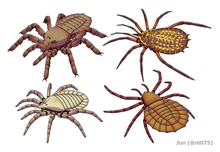| Trigonotarbida Temporal range: Late Silurian to Early Permian
| |
|---|---|

| |
| Palaeocharinus rhyniensis, Eophrynus prestvicii, Trigonotarbus johnsoni and Maiocercus celticus | |
| Scientific classification | |
| Domain: | Eukaryota |
| Kingdom: | Animalia |
| Phylum: | Arthropoda |
| Subphylum: | Chelicerata |
| Class: | Arachnida |
| Order: | †Trigonotarbida Petrunkevitch, 1949 |
| Families | |
| Synonyms | |
| |
The order Trigonotarbida is a group of extinct arachnids whose fossil record extends from the late Silurian to the early Permian (Pridoli to Sakmarian).[1][2][3] These animals are known from several localities in Europe and North America, as well as a single record from Argentina. Trigonotarbids can be envisaged as spider-like arachnids, but without silk-producing spinnerets. They ranged in size from a few millimetres to a few centimetres in body length and had segmented abdomens (opisthosoma), with the dorsal exoskeleton (tergites) across the backs of the animals' abdomens, which were characteristically divided into three or five separate plates.[1] Probably living as predators on other arthropods, some later trigonotarbid species were quite heavily armoured and protected themselves with spines and tubercles.[4] About seventy species are currently known, with most fossils originating from the Carboniferous coal measures.
- ^ a b Garwood, Russell J.; Dunlop, Jason A. (2010). "Fossils Explained: Trigonotarbids". Geology Today. 26 (1): 34–37. doi:10.1111/j.1365-2451.2010.00742.x. S2CID 247708509. Retrieved June 12, 2015.
- ^ Dunlop, J. A.; Rößler, R. (2013-08-01). "The youngest trigonotarbid Permotarbus schuberti n. gen., n. sp. from the Permian Petrified Forest of Chemnitz in Germany". Fossil Record. 16 (2): 229–243. Bibcode:2013FossR..16..229D. doi:10.5194/fr-16-229-2013. ISSN 2193-0074.
- ^ Dunlop, J. A., Penney, D. & Jekel, D. 2020. A summary list of fossil spiders and their relatives. In World Spider Catalog. Natural History Museum Bern, online at http://wsc.nmbe.ch , version 20.5
- ^ Dunlop, Jason; Garwood, Russell (2014). "Tomographic reconstruction of the exceptionally preserved trigonotarbid arachnid Eophrynus prestvicii". Acta Palaeontologica Polonica. doi:10.4202/app.2012.0032.